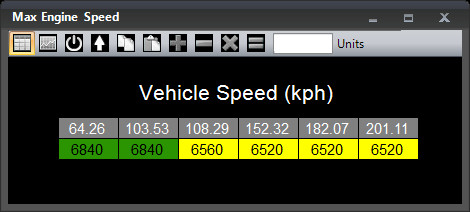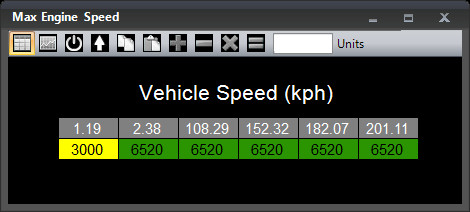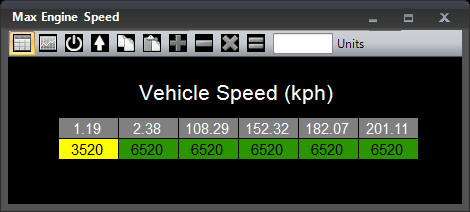Now, there are some limitations to this launch control and it should be considered a 'pseudo' launch control. The reasoning is because true launch control systems that are in some aftermarket ECUs and modern cars (such as the Nissan GTR) are more complex. These systems actually monitor the wheel speed and adjust the engine's torque output to obtain the perfect launch. This type of launch control requires very complex closed loop control algorithms. Unless the stock Bosch 3.3.1 DME control logic is rewritten, this just isn't possible. However, an easier approach which yields similar results is to modify the maximum engine speed map. The only caveat is that this map is only present in the 506 DME and the 413 DME with 8715 software. Other variants of the 413 software use a single value to define the maximum engine speed. However, we at Renovelo have some ideas that should make this possible for anybody.
Stock Max Engine Speed (506_7965)

As can be seen in the image above, this map uses vehicle speed to define the maximum engine speed. In order to add launch control to your car, it is only necessary to change three values: the first two values along the speed axis and the first engine speed value. That's it!
Now before changing these values, it's important to understand how the DME interpolates values from the maps. When using this map in the stock form, the DME will set the rev limit to be the first value of this map until the vehicle speed goes above 64kph. After the vehicle speed goes above 64kph, it will then linearly interpolate the rev limit between the first cell (6840) and the second cell (also 6840). It will continue this process all the way up to the last vehicle speed cell. If the vehicle speed surpasses 201kph, the rev limit will be the value in the last cell (6520rpm).
This concept is important to comprehend because in order to successfully modify this map to enable launch control, the speed axis must be changed appropriately. For launch control, we want to have the rev limit at a reduced value while the vehicle is stopped. We accomplish this by changing the first engine speed value to 3000rpm as can be seen below. Now, if you changed only this engine speed value and nothing else, the car would not be very fun to drive. What would happen is the rev limit would be 3000rpm until the vehicle eclipsed 64kph. After 64kph, the rev limit wouldn't magically jump to 6840rpm, but instead slightly increase over 3000rpm as the vehicle speed increased. This is why we changed the vehicle speed axis also. The reason we chose 1kph as the first breakpoint is because the vehicle will (hopefully) be stopped on the starting line when engaging the launch control. If this is the case, the rev limit will be the expected 3000rpm since the vehicle will be below 1kph. We made the second breakpoint 2kph because after the clutch is quickly disengaged, the wheel speed will almost instantaneously jump above 2kph. At this point, the DME will interpolate the rev limit between the second and third cells which are both set at 6520rpm.
Note: We're not quite sure why, but the engineers at BMW decided to have a varying rev limit for the M3. This can be left as is, but we decided to make the rev limit be 6520rpm after the car was launched just for consistency.
Launch Control at 3000rpm

You'll notice that 3000rpm was a little low for this application because the engine bogged slightly after disengaging the clutch. Therefore, we increased the launch speed to 3520rpm. This resulted in a much better launch as can be seen in the video below! The value that works best for you will vary based on multiple conditions such as engine torque at the launch rpm, tires, suspension, ground temperature, surface roughness, as well as many other factors. Therefore, it will be important to (safely!) experiment with the launch rpm to find a good value. Remember, this value could also change over time based on the track and environmental conditions.
Launch Control at 3520rpm
